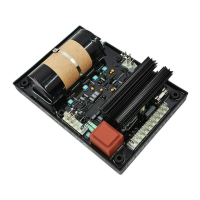Installation and maintenance
R448 & R448 V50
A.V.R.
3972 en - 02.2008 / d
LEROY-SOMER
9
3.2 - Frequency compared with
voltage (without LAM)
3.3 - LAM (Load Acceptance
Module) characteristics
3.3.1 - Voltage drop
The LAM system is integrated in the
regulator, as standard it is active (ST5 with
bridge). It can be deactivated by removing
the ST5 bridge. It can be adjusted to 13%
or 25% by means of the ST10 jumper.
- Role of the “LAM” (Load Acceptance
Module):
On application of a load, the rotation speed
of the generator set decreases. When it
passes below the preset frequency
threshold, the LAM causes the voltage to
drop by approximately 13% or 25% and
consequently the amount of active load
applied is reduced by approximately 25%
to 45%, until the speed reaches its rated
value again.
Hence the LAM can be used either to
reduce the speed variation (frequency) and
its duration for a given applied load, or to
increase the applied load possible for one
speed variation (turbo-charged engine).
To avoid voltage oscillations, the trip
threshold for the LAM function should be
set approximately 2 Hz below the lowest
frequency in steady state.
It is advisable to use the LAM at 25% for
load impacts Š 70% of the genset rated
power.
- LAM : action eliminated by cutting the ST5
jumper.
3.3.2 - Gradual voltage return function
During load impacts, the function helps the
genset to return to its rated speed faster
thanks to a gradual increase in voltage
according to the principle:
- If the speed drops between 46 and 50 Hz,
the rated voltage follows a fast gradient as
it is restored.
- If the speed drops below 46 Hz, since the
engine needs more help, the voltage
follows a slow gradient as it returns to the
reference value.
100 %
50 Hz 60 Hz
Hz
50 Hz
48 Hz
57.5 Hz
60 Hz
oltage
Bend
U/U
N
Frequenc
LAM
U
N
0
48 or 57.5 Hz
0.85 U
N
U/f
50 or 60 Hz
fC
fN
Voltag
ST5 disconnected
ST3
P2
Underspeed and LAM
Time
Drop N ≤ 46 Hz
Drop N > 46 Hz

